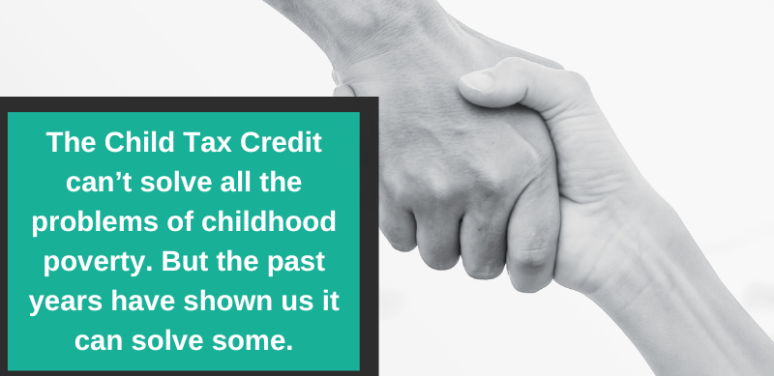The Expanded CTC: Another step in the right direction in the war on childhood poverty

by Mike Gunning and Dana Goldstein, staff attorneys
In so many ways, the pandemic taught us lessons. It magnified long-time truths, making them easier for many of us to see.
One such lesson (highlighted in Big Ideas last year) was the positive impact of the Child Tax Credit (CTC) on low-income families with children. During the public health emergency some restrictions that limited the scope of the CTC, including the earning requirements were lifted. Our nation’s child poverty rates dropped by around 25%. For the first time, these benefits were reaching families living in the deepest pockets of poverty.
H.R. 7024 - the “Tax Relief for American Families and Workers Act of 2024”, a new bipartisan agreement expanding the Child Tax Credit may soon become law. According to the Center on Budget and Policy Priorities, “In the first year, the proposal would lift as many as 400,000 children above the poverty line and make an additional 3 million children less poor as their incomes rise closer to the poverty line.” While poverty advocates may not find the new policy perfect, it will expand the Child Tax Credit in meaningful ways including:
- Increasing the refundable portion of the CTC: Initially the CTC was designed to be a credit meaning it offset any tax owed, but would never result in cash-in-pocket for recipients. Since most low-income families don’t have tax liability, this meant the CTC didn’t help. Currently, the refundable CTC amount is limited to $1,600 per child. Under the new policy, this will increase to $1,800 per child in 2023, $1,900 in 2024, and $2,000 for 2025.
- Allowing for a lookback period to maximize eligibility: Under the new policy, the taxpayer may elect to use earned income from either the current tax year or the previous tax year to calculate the CTC. This will enable families to maximize the credit amount in spite of fluctuations in income that might take them above or below CTC thresholds.
- Ensuring fairness for larger families: Under current CTC policy, the maximum refundable credit amount is calculated by multiplying earned income in excess of $2,500 by 15%. Under the new policy, the maximum refundable credit amount will increase for larger families by using a new calculation: amount of earned income over $2,500 x 15% x the number of qualifying children
Even as the CTC changes to reach more children than ever, additional changes that could lift more low-income children out of poverty could be implemented which include:
- Expansion to include different forms of income: In its new form, the benefits of the CTC will still be out of reach for many members of our society who care for children and desperately need help. For example, kinship caregivers without earned income would not qualify. Often in the US, this looks like grandparents caring for grandchildren while living on social security. An extra $4,000 per year from the CTC means more than $300/ month to help these families with groceries, gas, utilities, and rent. Other groups that will remain excluded from the CTC are parents on SSI or disability and parents who are receiving benefits from the Department of Veterans Affairs. These income streams are not considered earned income.
- Decreased or removed earned income requirements: If COVID-19 taught us anything in this arena, it’s that good things happened for our poorest families when we removed the earned income thresholds for our families. Consider, for example, a new mother divided between her role as caregiver and provider for her family. If she joins the workforce late in the calendar year or can only work part-time, it’s unlikely she will meet the current income requirements for the CTC. But she is certainly adding expenses such as transportation and childcare to participate in the workforce. Reducing, or eliminating the earnings requirement gives families the space and support to grow, while helping them meet basic needs. This change could also remove workload from the IRS as they are tasked with monitoring CTC payments and fraud. We have to ask ourselves - is this tedious work worth the return? Or would we instead enjoy a win-win by removal of these restrictions?
As we continue to understand how deeply impactful this type of assistance can be for our country’s poorest families, we must stay focused on what matters most. Our children are our future - and living in poverty is harmful to them. It’s easy to imagine short term impacts, like hunger, trouble achieving in school, poor health, and the daily impacts of toxic stress on a household. But we also know the long-term consequences are far-reaching and debilitating, including continuation of the cycle of poverty, lower economic prospects, and poorer physical and mental health.
The Child Tax Credit can’t solve all the problems of childhood poverty. But the past years have shown us it can solve some. If this law is passed, we will watch with interest how this expansion of the CTC helps the American youth who need it most - while continuing to call attention to those who fall outside the scope of assistance.
This article is part of Legal Aid’s “Big Ideas” series.
Sign up to get Big Ideas in your inbox
